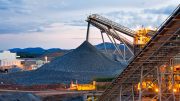It’s December — time for our year in review. This year was notable for takeovers. Newmont paid US$21.2 billion for copper-rich gold miner Newcrest Mining; Glencore negotiated a US$8.9-billion deal for Teck’s coal business; and a raft of lithium deals included the US$10.6-billion all-share merger between Allkem and Livent, expected to close in January.
It was also a year in which uranium and lithium — two key metals required to meet global net zero ambitions — followed opposite trajectories. The uranium price reached 15-year highs of over US$80 per lb. in November on anticipated supply shortages.
However, as EV markets and the global economy have slowed this year, lithium carbonate prices have fallen a spectacular 75% to under US$20,000 per tonne in late November. At current prices, some mines could become unprofitable and mine closures may be necessary to bring the market into balance, BMO Capital Markets said in a recent note.
But aside from big mergers and commodity price movements, another defining theme of 2023 was access to resources — whether mineral or cash.
Resource nationalism
This year, states with in-ground critical minerals (including Canada) have found themselves courted by just about everyone. With major economic powers and big companies alike seeking access to raw minerals, governments have responded by upping the cost. They are asking for money, yes, in the form of royalties and a slice of assets for the state, but also more downstream investment to jumpstart their own mineral processing and battery manufacturing industries.
Mexico, Chile, and Mali are among the countries that have passed new laws this year imposing new restrictions on mining or handing the government more control and a direct stake in key critical resources — notably lithium. Meanwhile, Panama’s government banned any new mines or contract extensions in November in the face of widespread protests. That’s even though its October deal with First Quantum Minerals guaranteed the state US$375 million a year in royalties. That deal’s now been struck down by the country’s Supreme Court, and the mine ordered to close.
Global power shifts also add uncertainty. Both China (graphite, germanium and gallium) and the United States (semiconductor chips) restricted the movement of strategic minerals and industrial inputs. This after the U.S. unleashed hundreds of billions worth of spending through its Inflation Reduction Act last year toward breaking China’s grip on raw materials, manufacturing and supply chains that fuel green energy and advanced technologies.
At the same time, Saudi Arabia has announced its entry into the global mining business, deploying some of its oil spoils into the sector. This year, it bought a 10% stake in Vale’s new base metals unit, partnered with Ivanhoe Electric and Barrick Gold on exploration in the kingdom, and formed a new company to invest in critical minerals abroad.
Capital
Access to that other critical resource, capital, rocketed up to the No. 2 risk in EY’s annual mining risks and opportunities survey of mining executives this year. It was No. 8 last year. While the need for capital is gaining attention, debt and equity raised for mining in the first seven months of the year barely budged compared to the same period in 2022 (US$196 billion vs.US$192 billion last, according to the report released in October).
There is some money coming into the sector from new sources — automakers, battery manufacturers and governments. The competition for control of critical minerals and supply chains has begun to get serious, with governments showering industry with incentives for mining, technology and manufacturing development. But capital isn’t flooding into the mining space. Investments paled when compared with the as much as US$4 trillion analysts at McKinsey recently estimated is needed before the end of the decade in order to produce enough metals for the energy transition.
Capital has become more dear since a succession of interest hikes began last spring, with muted prospects for capital raising and spending in the near term. North America’s economy looks ready to tip into a long-predicted recession. The U.S. Conference Board’s Leading Economic Index has now fallen 7.6% over the past year, Canaccord Genuity said in a research note in late November. “Over the past 60 years, a fall of this magnitude has always been associated with a recession,” Canaccord said.
Exploration companies, tasked with discovering the future mines that will soon be needed, are suffering from near total investor indifference. The junior mining-heavy TSX Venture Index is hovering near lows last seen in late 2015/16 on weak metals prices and disillusionment with the mining sector. (It dipped lower only briefly at the start of the COVID-19 pandemic).
Turnaround coming?
Contrast the current period with the glory days of mining in the early 1990s. Many of the industry’s biggest names got their start then – at a time when the world was opening up to mining and cash flowed freely. Legendary mining financier Frank Giustra, who catapulted brokerage Yorkton Securities into a mining investment powerhouse at that time, anticipates a secular bull market for base, battery, and precious metals, driven by heightened competition for resources.
“The world is changing all the time and there’s always opportunity,” Giustra told The Northern Miner’s Canadian Mining Symposium in London, U.K., in October.
“It’s gonna get ugly out there, and this is going to be a time where the mining industry is going to be very, very active. There will be a lot of capital coming in when the sentiment changes.”





Be the first to comment on "2023’s key theme? Narrowed access to resources — whether mineral or cash"